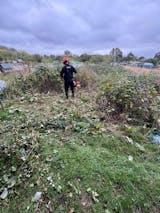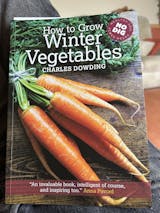Covers on weeds and against insects
Above is my "new area" since 2021, now clear of convolvulus. We covered a weedy corner in February with black plastic and 7 cm compost underneath. This is 25th September with new beds after plastic removed, compost scraped from 40 cm paths, see below.
Covers are mesh and fleece, on plants susceptible to insects and rabbits, sometimes also needing warmth. Under them above are Chinese cabbage, salad rocket, turnips and winter radish. Sometimes I use 12mm bird netting, to protect plants such as overwintering broccoli, against pigeons, rabbits, and deer. It does not protect against insects, or give warmth,


Making perennial weed roots disappear
We have eliminated Convolvulus arvensis or bindweed through removal every week over two whole summers, of any new regrowth. A trowel means we lever out the new, white roots, to a length of about 10 cm/4". They all go on the compost heap.
The deeper roots, we never removed, but they have limited energy and eventually die, usually after two summers of doing this.
The difficult part is keeping edges clean from invading deeper roots. As in the next photo, close to a weedy corner.

Fleece and mesh
Heading into autumn, there are fewer insects, and it's turning colder. Increasingly now, I favour fleece over mesh, but even a mesh cover is excellent for giving some wind protection.
For example, I keep such a cover, all through winter and early spring, over spring cabbages we are transplanting now. Mesh gives great protection to small brassicas, against pigeons in particular.


Compost making, and turning?
In my new video, I show how you can turn a heap more easily. Not that it's vital to do. There are no absolute rules in making compost, but understanding the principles helps you to work out a best method in your location, and for the size of garden you have.
My new book addresses these factors. Also, we are offering it as a discounted double pack with No Dig, in my webshop.

Composts for starting no dig
What is this word compost?
I define it as anything more than half decomposed, and it does not need to be perfectly fine and crumbly. You can use it unsieved and sometimes a bit lumpy, even with small pieces of wood visible.
Options to buy are green waste and mushroom compost (Somerset supplier) and old animal manure. All are suitable at any stage and green waste compost is cheapest when starting out. It's carbon, food for soil life!
In 2024 we spread 4 cm of it in February on top of mown weeds and grass, see my earlier blogs. Then 3 cm mushroom compost on top, covered with black plastic. From squash planted 17th May, we took a harvest of winter squash.
Now we have made beds in this area of 66 m².



Patio vegetables
We made a video about this, published 7th October approx.
I've been trialling a few things this summer and the video explains how it has worked out. On the seed packets for the butternut squash, they say you can get 4 to 5 fruits from each plant. I guess that would need a much bigger pot!

New sowings
There are very few. Mainly garlic and now we're in a waxing moon, with favourable conditions in that sense until mid month. Up until two days before the full moon of 17th, for stronger growth subsequently.
You can sow broad beans to overwinter small, from late October. Except for colder climates such as Scotland, I recommend not to sow too early. I find here at least, that late October until around mid November works well, either sown direct or one seed per CD module cell. Plants need to be not too big in order to survive frost better.


New plantings under cover
By 20th October, I plan to have all of the polytunnels and greenhouse planted with transplants of brassica salads, lettuce, endive, claytonia, and more.
For six months of winter harvests, see video.

Harvest time of summer succession plantings
I hope that you are enjoying many flavoursome harvests. Cabbage and cauliflower are abundant here, in many forms and colours. Plus the first leeks are coming ready. When multisown, you get a lot! Just none of them are giant leeks.
The Jolant variety matures early, which means we can start harvesting now before there is too much risk of the horrible new pest, Allium leaf miner. Prevalent by November last year, but I don't want to cover all leeks!


The cabbages were sown 8th May, transplanted mid-June after broad beans that overwintered.













































0 comments